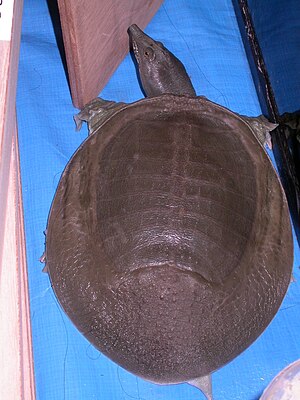Chinese softshell turtle
| Chinese softshell turtle | ||||||||||||
|---|---|---|---|---|---|---|---|---|---|---|---|---|

Chinese softshell turtle ( Pelodiscus sinensis ) |
||||||||||||
| Systematics | ||||||||||||
|
||||||||||||
| Scientific name | ||||||||||||
| Pelodiscus sinensis | ||||||||||||
| ( Wiegmann , 1835) |
The Chinese softshell turtle ( Pelodiscus sinensis ) belongs within the family of the softshell turtles (Trionychidae) to the genus of the Far Eastern softshell turtles ( Pelodiscus ).
description
The Chinese softshell turtle reaches a body length of 15 to 25 centimeters. Males stay significantly smaller than females at up to 15 centimeters. The carapace is relatively flat, in the front area of the carapace there is an elevation, a kind of hump. As with all softshell turtles, the shell of the Chinese softshell turtle is not rigid, but soft and flexible. The surface of the carapace is smooth and mostly olive green to olive brown in color. The ventral plastron is predominantly whitish to cream colored. The plastron of the juvenile animals is red. Like the carapace, the plastron also looks leathery. The neck is long and significantly thinner than the massive head. There are some lighter spots around the head, especially under the eyes. The tip of the nose is transformed into an elongated snorkel. Adult males and females cannot only be distinguished by size. In the male, the tail root is much thicker than in the female. The extremities end in long toes, each with a small claw. The Chinese softshell turtle has clearly visible webs between its toes, which make it a very good swimmer. The Chinese softshell turtle hibernates from October to March.
Hybridization
Researchers at the Senckenberg Research Institute in Dresden found that the Chinese softshell turtle originally described is not actually a species. Rather, it is a hybrid of different species. A genetic analysis of tiny pieces of tissue of the type specimens , which the German zoologist Arend Friedrich August Wiegmann used to describe the species Pelodiscus sinensis for the first time in 1834 , was carried out under the direction of Uwe Fritz in Dresden. It showed that the genetic make-up of the Chinese softshell turtles of that time was a mixture of at least four different species. Hybridization has mainly occurred in the breeding farms in which the animals are bred for consumption.
distribution
The Chinese softshell turtle is found in China , Japan , Korea and Vietnam . In China, it is particularly widespread in Jiangsu, Anhui, Hubei, Hunan, Jiangxi, Zhejiang and Henan provinces. Lakes, ponds, floodplains and slow-flowing streams and rivers are preferred as habitats. Most of the time, Chinese softshell turtles live in the water, they only come on land to sunbathe and lay eggs. When resting in the water, it is mostly buried in the ground. The waters usually have a muddy bottom. This is where the turtle can burrow particularly easily and quickly.
Threat and protection

The wild population of the Chinese softshell turtle is on the verge of extinction. In China and Taiwan in particular , this turtle is considered a delicacy. The Chinese softshell turtle is also used in traditional Chinese medicine . As a result, the demand for these animals is quite high, the Chinese alone eat an estimated 300 million copies annually, but these come mainly from breeding farms. The destruction and drainage of natural habitats has also contributed to this misery. The Chinese softshell turtle is listed as endangered in the IUCN Red List .
nutrition
Chinese softshell turtles are omnivores . The preferred food includes fish , snails , worms , mussels , crustaceans such as shrimps and crabs , insects and their larvae and amphibians of all kinds. Occasionally the animals also eat aquatic plants. But only to a small extent.
Reproduction
The breeding season begins in most of the distribution areas between April and August. During this time there can be two to three clutches. Earlier in southern areas than in northern areas. The female of the Chinese softshell turtle lays her eggs in self-dug hollows at depths of up to ten centimeters. The hollows are created on sandy and sunny banks. Usually a few meters from the shore, as the egg-laying area must not be flooded. A clutch consists of 15 to 30 soft-shelled eggs. The eggs measure 16 to 24 millimeters in diameter. The young turtles hatch after 60 to 90 days, depending on the incubation temperature. In the northern distribution areas, hatching can take up to 120 days. The young animals have a carapace length of 23 to 28 millimeters. They are sexually mature when they are around six years old.
Individual evidence
- ↑ a b Hans Schuh: The missing witness longer . Die Zeit , 5, of January 26, 2012 ( Zeit Online , accessed February 20, 2012).
- ^ Asian Turtle Trade Working Group (2000): Pelodiscus sinensis. In: IUCN 2011. IUCN Red List of Threatened Species. Version 2011.2. Retrieved February 20, 2012.
literature
- Dieter Gramentz: The Chinese softshell turtle: Pelodiscus sinensis. 1st edition. Natur und Tier-Verlag, May 26, 2010, ISBN 978-3866591394 .
Web links
- Asian Turtle Trade Working Group (2000): Pelodiscus sinensis. In: IUCN 2011. IUCN Red List of Threatened Species. Version 2011.2. Retrieved February 20, 2012
- http://www.geo.de/GEO/natur/tierwelt/65080.html
- http://www.testudowelt.de/?p=83
- Pelodiscus sinensis in The Reptile Database
